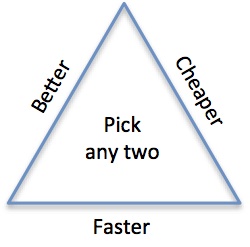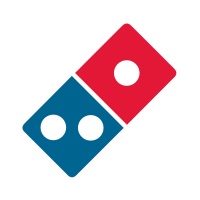When Competing on Speed Makes a Difference
 A popular phrase amongst marketers is: “Better. Faster. Cheaper. Pick any two.” In other words, customers can have high quality and/or faster service, and/or or a low price – but never all three. This is one of those principles that’s inherently understood by marketers.
A popular phrase amongst marketers is: “Better. Faster. Cheaper. Pick any two.” In other words, customers can have high quality and/or faster service, and/or or a low price – but never all three. This is one of those principles that’s inherently understood by marketers.
Lots of companies focus on producing high quality. It’s a characteristic that just about any company – big or small, established or startup – can choose to compete. Many firms also choose to compete on price. They work hard to lower prices by locating cheaper suppliers, reducing waste, or inventing new ways to do things at a lower cost. But such marketers need to be aware of another principle that has also proven to be true: no company can win on lowest price over the long-term. Those who try are only racing to the bottom, which never ends well.
However, the third element of doing things faster has proven to be a competitive advantage for various businesses, in all kinds of different industries. This is often where start-ups and smaller firms build their business, because they can be more nimble and move quicker.
But never underestimate what mid-to-large-sized firms can do too. Once they get their act together and re-focus their marketing machines, such companies can also compete on speed.
As a differentiating value, Speed means accomplished rapidly and without delay; a fast rate of motion or change of distance.
When everything else is equal, speed can often win the race, and the sale.
Building an Industry around Speed
Speed has been a key differentiator in the “Fast Food” industry since it began. There’s a reason the industry has that name. Generally, the food quality is regarded as “acceptable” and the prices are quite low (often lower than making it yourself). But what customers expect most is fast service.
Speed has become the hallmark of this industry. And once expectations have been set, it’s like there’s a minimum threshold to even stay in the game. For example, if you have ever had to wait longer than 2 minutes for your order at McDonalds or Burger King, you likely were starting to get really annoyed. Maybe you even said something to the staff, or just grumbled something about never coming back. We not only expect fast service from a fast food establishment, we demand it.
So when quality and price are pretty much established. The name of the game is speed.
Fast Food Delivery
 You might be surprised to know when speed became a gamer changer in the pizza business. Domino’s Pizza began promising delivery of your pizza “30 minutes or free” back in 1973 (I was surprised to learn it was that long ago). This proved to be a huge competitive advantage for Domino’s, helping them expand from 3 stores in 1969 to over 10,000 locations worldwide today.
You might be surprised to know when speed became a gamer changer in the pizza business. Domino’s Pizza began promising delivery of your pizza “30 minutes or free” back in 1973 (I was surprised to learn it was that long ago). This proved to be a huge competitive advantage for Domino’s, helping them expand from 3 stores in 1969 to over 10,000 locations worldwide today.
Interestingly, Domino’s Pizza dropped this guarantee in the early 1990’s because of a growing public perception of “reckless driving” due to the 30-minite promise. This came on the heels of two major lawsuits against Domino’s Pizza, due to a fatality and injuries sustained from collisions with delivery drivers. But even without the official guarantee, the brand promise of fast delivery lives on.
In spite of such risks that come with promising fast delivery, another fast food chain tapped the value of speed in recent years. Jimmy John’s Gourmet Sandwiches adopted “Freaky Fast Delivery” as a key differentiator. This humorous video portrays the need for speed in corporate America, The subtle message here is that when you have a demanding boss and time is of the essence, you can be the hero at work by ordering lunch from Jimmy John’s.
But rather than making a specific guarantee (e.g. 30 minutes or free), they chose to keep the promise of speed as conceptual, by simply stating “freaky fast.” How fast is that? Faster than you expect, which leaves it open to the interpretation of the customer. This is a smarter – and safer – decision.
Speed in Other Industries
Can speed provide a competitive advantage in industries outside fast food? Absolutely.
Speed is the hallmark of many sign makers and printers. Speed has also become a key differentiator in service businesses, such as graphic design and copywriting.
What about in a highly competitive field, such as insurance? Providing the ability to obtain a fast quote is successfully being used to attract prospects and close more sales, such as GEICO’s promise of “15 minutes could save you 15% or more.”
In just about every industry, there is room to look at speed as a differentiating value. The trick is being able to deliver fast service consistently, reliably, safely, and in a time frame that matters to customers. And of course…. all the while maintaining a profitable operation.
Have you experienced a brand that used speed as a competitive advantage? How did they do it?
Today’s value was selected from the “Determination-Focus” category, based on the e-book Developing Your Differentiating Values.







